The Bradleys and the Nine-Mile Meadow
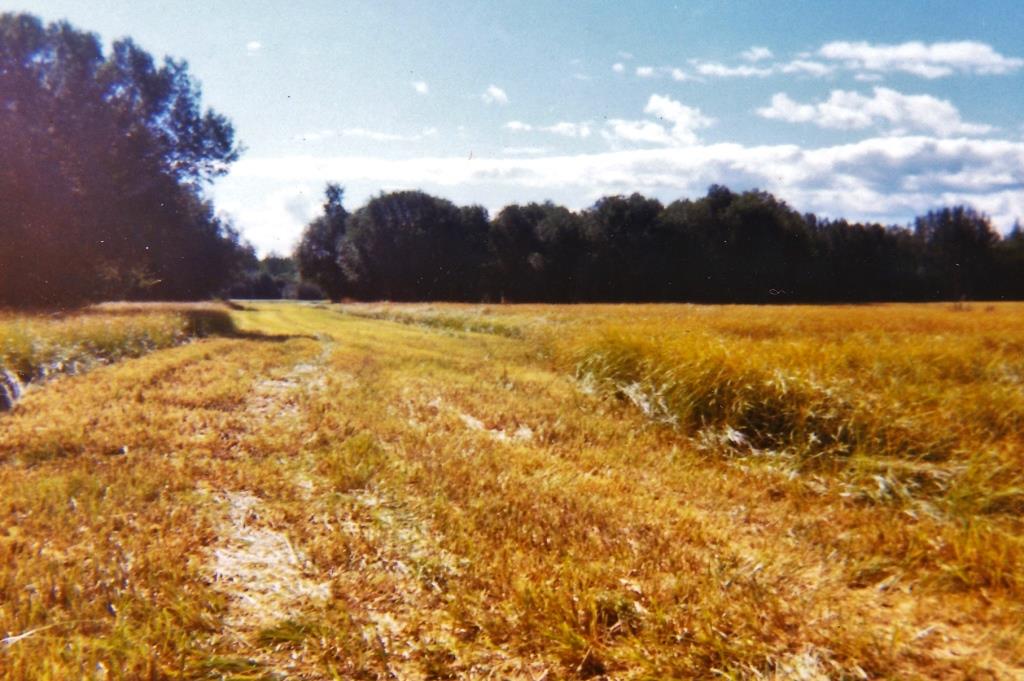
(Gord Allison photo)
In the 1960s and early 1970s, the Bradley brothers of the Pelly River Ranch harvested wild hay from a meadow south of the Pelly River that they called the Nine-Mile meadow. Their haying equipment first had to be ferried across the river, then taken along nine miles of narrow bush road to get to the meadow. The cut hay was later hauled back to the ranch to supplement the hay and grain that was grown there to feed their livestock, mainly cattle.
Cutting hay at the Nine-Mile meadow was one of the more memorable activities during summers at the ranch in my young days. Many years later, research of archival records revealed that the use of this meadow for haying began by 1899. It is one of many natural meadows in the Yukon that were part of a busy but short-lived haying industry following the Klondike gold rush. It continued on after that as a smaller-scale localized activity, and the Bradleys may have been the last to do so.
Yukon Meadow Haying
The harvesting of wild hay from Yukon meadows began in a significant way in the late 1890s to feed the large numbers of livestock being brought in to serve the needs of Klondike gold rush developments. The Dawson newspaper Klondike Nugget of October 14, 1899 reported that “Dawson’s hay wagons – [in the form of] rafts – are just in from the hayfields and for half a mile are securely anchored to the beach”. This was said to have amounted to 350 tons of hay and it was handled by compaction with a hay press set up on the shore.
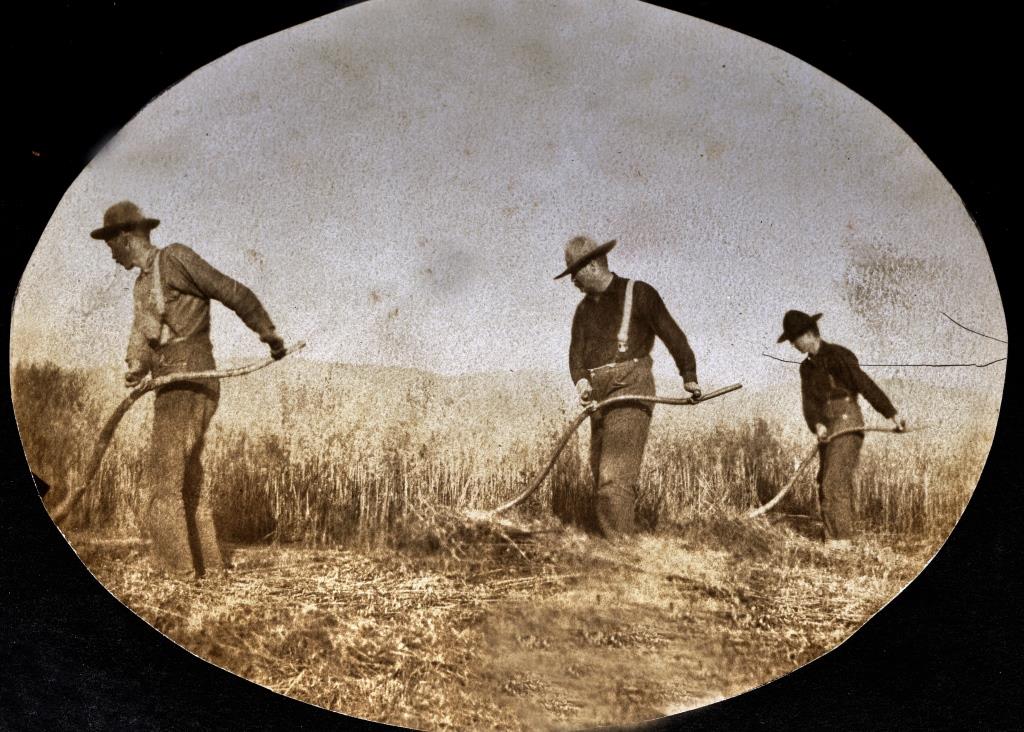
(Coltrin family collection)
This scale of cutting hay from natural meadows only lasted a couple of years until being replaced by imported hay as well as developing farming operations in the Klondike region. However, harvesting some of these meadows continued on as a smaller local industry, mainly by livestock owners for their own use, but also some for sale. The federal government issued permits and leases for these endeavors from the start, and these records provide some insight into the activity. Some known cutting of hay meadows has no such documentation, indicating there was more of it carried out than is contained in the records.
The archival records and a number of newspaper articles show that harvesting of Yukon wild hay was carried out from places near Fortymile, Dawson, and Mayo in the north to Tagish, Champagne, Dezadeash Lake, and Burwash Landing in the south. Between these extremities, in and around the Minto-Fort Selkirk-Pelly Crossing triangle of the central Yukon, there were at least nine meadows known to be harvested for hay. One of these was the Nine-Mile meadow that the Bradleys cut, but it was first called the ‘central Morrison meadow’. It is the subject of Part 1 of this article, and the others will be looked at in Part 2.
The Central Morrison Meadow (later the Nine-Mile Meadow)
Long before the Bradleys’ time cutting their Nine-Mile meadow, it was first known as the central meadow of three called the Morrison meadows. It is about 2½ miles east of the Yukon River from Hells Gate, a section of the river 10 miles up (south) from Fort Selkirk that often presented navigational problems for steamboats. The two other Morrison meadows were each located about two miles from the central meadow, one closer to the river and the other farther inland.
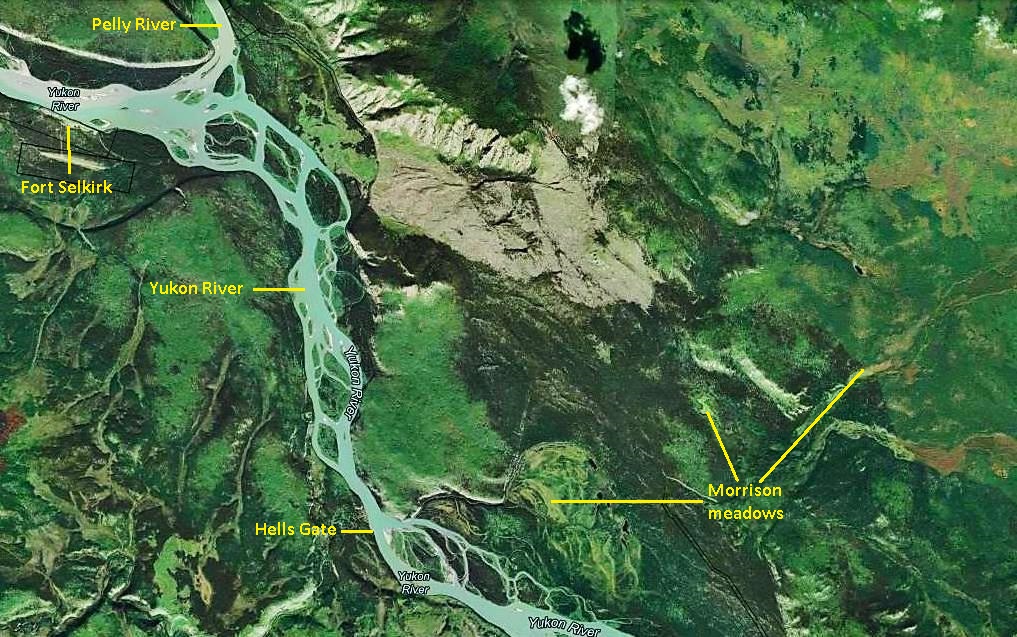
(GeoYukon)

(GeoYukon)
In 1902, a few years after the central Morrison meadow began to be harvested, the Dawson-Whitehorse Overland Trail was put through about halfway between it and the Yukon River. A few years after this, a new routing of the Trail passed by within a quarter of a mile of the meadow. These roads were long abandoned by the time the Bradleys moved into the area in 1954, but they still provided access for the hay to be harvested from it.
The meadow is hidden in the bush with no obvious nearby landmark nor natural features that would guide a person on the ground to it. There is thick willow growth around its edges, and beyond that is a white spruce forest intermixed with trembling aspen. The meadow has a type of mint growing in it that gives the air a distinct minty aroma on a calm summer day.
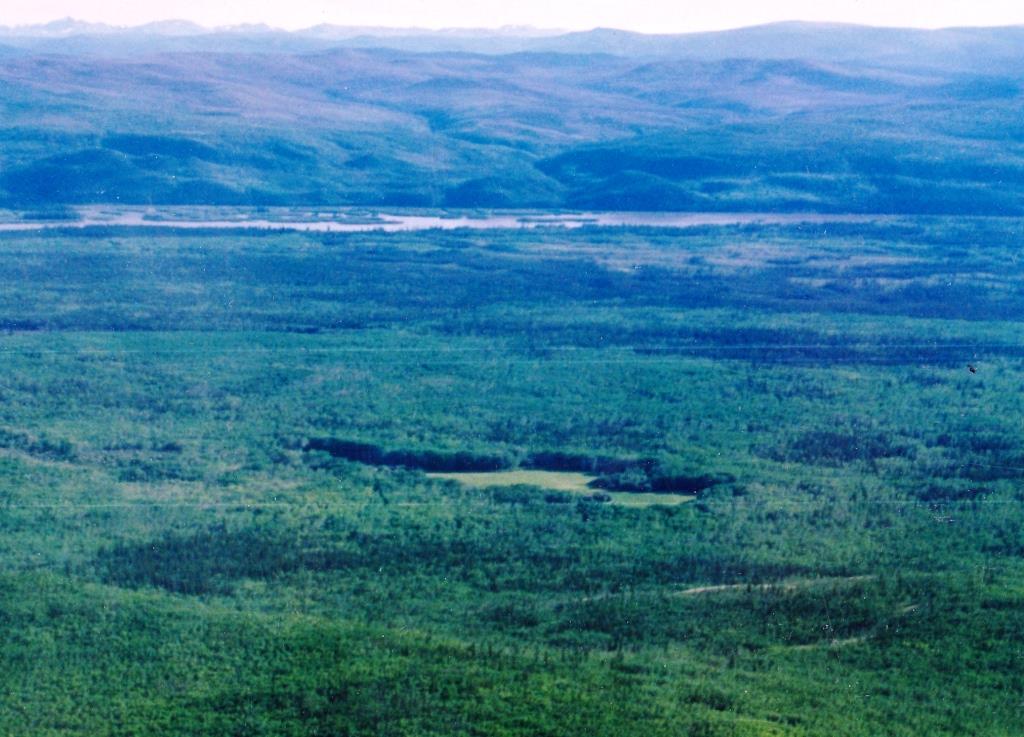
(Gord Allison photo)
The meadow has no obvious inlet or outlet, but is a shallow catchment basin that fills with water in the spring and dries up in the summer. The yearly flooding is likely what has kept the trees back and allowed the meadow to persist over the past century and more, although it is gradually getting smaller. It was said to be 50 acres in size in 1899, and if that estimation was correct then it is now about a quarter of that at around 12 acres. It was an open grass meadow when the Bradleys were cutting it in the 1960s and ‘70s, but there are now patches of willow gaining a foothold within it.

(GeoYukon)
At some point somebody became aware of the haying value this meadow presented. In November 1899, Alex Morrison of Dawson applied to the government for a lease of this and the other two sites of “hay land”. His application included a fairly detailed sketch showing the locations of the three meadows, one of them 150 acres in size and two others of 50 acres.
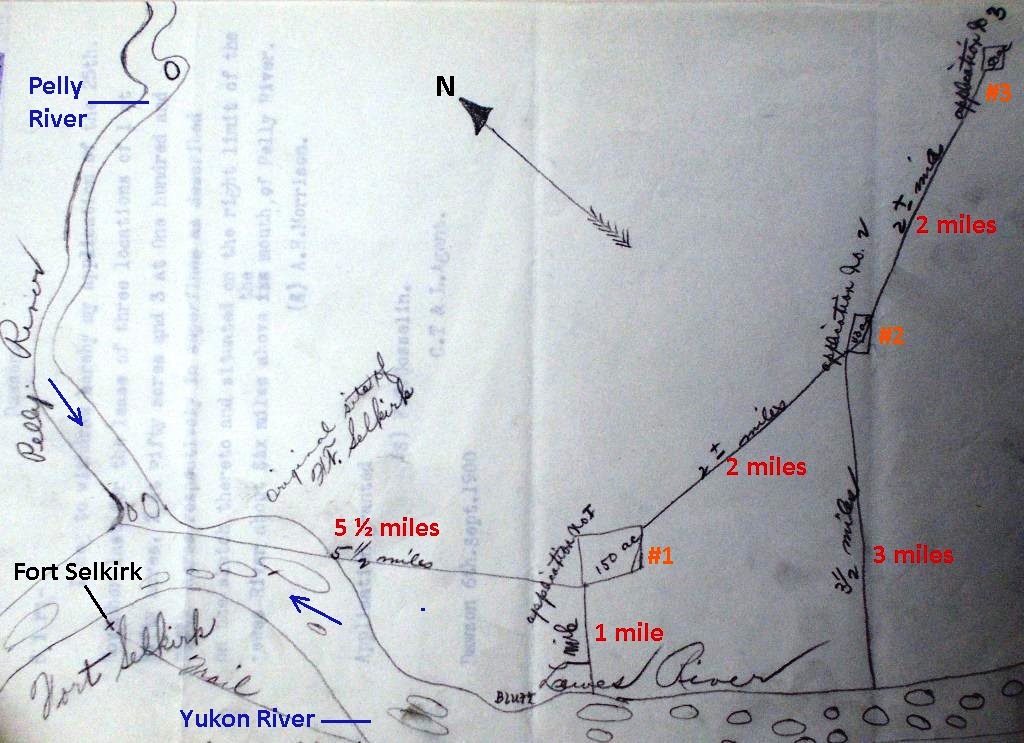
(Library & Archives Canada, RG85 Vol. 1519, File 1582)
The October 14, 1899 Klondike Nugget newspaper article that described the rafts of hay at Dawson also said that much of it had come from along the Yukon River above Fort Selkirk, a description that fits with Alex Morrison’s application. He gave up his lease the following September of 1900, but by then his name was already associated with the meadows. In March 1903 William Atkinson, an area homesteader, applied to purchase the “central meadow of the three known as the “Stone Meadows” or the “Morrison meadows””. I have not determined what the Stone Meadows reference is about.
For how long Atkinson or anyone else cut hay from this meadow is not known, but by 1960 it began to be used by the relatively new owners of the Pelly River Ranch, Dick and Hugh Bradley, with later involvement of their brother Ken. They called it the Nine-Mile meadow because of its distance from the ranch along a road they had built that came near it. The history of this road and the others in the area can be confusing, and an understanding of them is beneficial.
The Overland Trail and the Old Pelly Farm Road
In the early 1900s two variants of the 330-mile Dawson-Whitehorse Overland Trail were built through the general area of what was then known as the central Morrison meadow. The first was the original route, constructed in the late summer and fall of 1902 as a winter road for horses pulling sleighs, or sometimes wagons in place of sleighs in the fall and spring shoulder seasons. This route of the Trail passed by within a mile to the west of the meadow. (see links to Overland Trail article at end)
The first seven miles of this route from Minto north to the Pelly River had some steep places and others that were subject to sluffing and erosion, making it dangerous and difficult to maintain. A few years later a new 20-mile second route to avoid this bad section was built north from Minto through a valley to the east of the Yukon River and passed by within a quarter of a mile of the central Morrison meadow. A further 2½ miles north, it rejoined the original route at a point seven miles south of the crossing of the Pelly River.

(Topographical Survey of Canada ‘Yukon Territory’, 1936)
By the time Dick and Hugh Bradley and their two partners took over operation of the Pelly River Ranch in 1954, the Overland Trail had been abandoned for over 30 years. It had been replaced by the modern highway system from Whitehorse to Mayo and Dawson that, for the most part, took an entirely different route. The Overland Trail became more commonly known as the Old Dawson Road (or Trail), with some portions remaining relatively intact. The 27-mile stretch from Minto to the Pelly River was still serviceable enough to enable the Bradleys and partners to haul in the farming equipment, supplies, and belongings they had brought with them from Alberta.
For the Bradleys’ first few years, this section of abandoned Overland Trail was their access to and from the highway near Minto. In summer the old road was a rough route that posed difficulties in wet weather and had a few muskegs to cross. In winter when the snow was getting too deep for their truck, they had to travel it by tractor when there was a need to go out to the highway for their mail and a few groceries at Alex Coward’s store at Minto and/or the nearby Midway Lodge.
A trip on the road also involved travel on the two miles of Pelly River between the ranch and the old crossing of the Overland Trail. This was on the ice in winter or by boat in summer, with no travel during spring break-up and fall freeze-up periods. Ed Chaisson, who lived at Midway Lodge on the highway near Minto as a boy and spent time with the Bradleys at the ranch in their early years, said that the summer travel was with a freighter canoe that had no motor. The trip upstream required the boat to be poled and lined (pulled by rope) against the current for the two miles up and across the river to the ranch.
In the late 1950s, with the assistance of a D-4 bulldozer loaned by the Haines Junction Experimental Farm, the Bradleys built 10 miles of new road off of the second Overland Trail route. The first mile was to connect with the highway at the top of the hill north of Minto, locally called Policeman’s Hill. The other nine miles were built from a point on the old road near the meadow and wound through the hills to the south bank of the Pelly River across from the ranch. This 26-mile route from the highway to the Pelly River became locally known as the Pelly Farm Road or Pelly River Road.
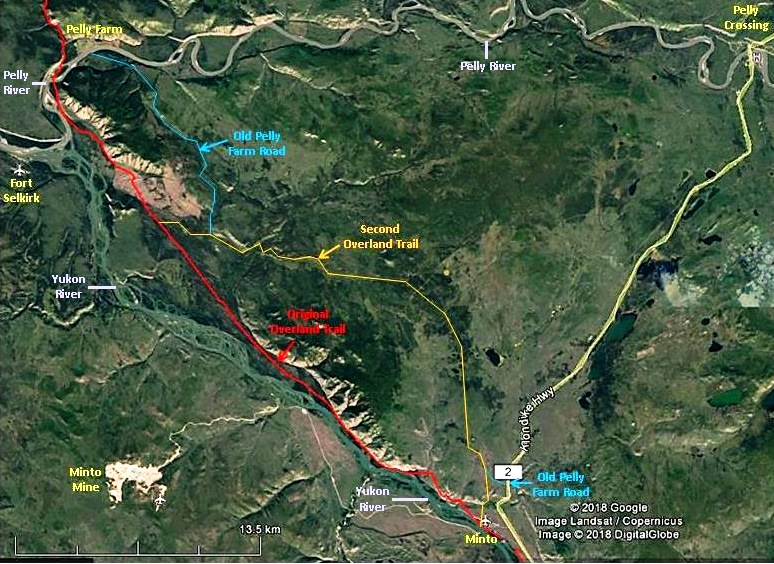
(Google Earth)
The new road provided the Bradleys with improved access to and from their ranch, particularly by eliminating the need to travel the two miles on the river to the previous Overland Trail crossing. However, it didn’t remove all the difficulties of travel in poor weather and at certain times of the year. When a trip to Whitehorse or elsewhere in winter required use of their truck, it was accompanied by the tractor out to the highway to pull it through the snow if or when needed. Dorothy Bradley recalled one such trip to Whitehorse when it had snowed a fair amount in their absence and the truck had to be pulled the whole way back to the ranch. She had a very difficult time driving the truck behind Ken on the tractor and staying in his tracks, while also keeping watch on her two small boys riding with her. She was totally exhausted after the 26 miles of this.
The new road had also provided better access to the hay meadow that was now only nine road miles away from the ranch and feasible to harvest. When the Bradleys ceased haying the meadow in the early 1970s, it also meant an end to their use of the road because the current Pelly Ranch Road from Pelly Crossing, completed in the late 1960s, was by then their primary access. The old road has since become known as the Old Pelly Farm Road or Old Pelly River Road.
The Bradleys and the Nine-Mile Meadow
The history of the Pelly River Ranch (known as Pelly Farm in the earlier years) goes back to at least 1901. In 1953 Dick and Hugh Bradley and two partners, Buck Godwin and John Stelfox, purchased the ranch from J.C. and Lura Wilkinson and made preparations to begin operating it the following year.
On April 17, 1954, Dick Bradley arrived at the original Overland Trail crossing of the Pelly River with their first load, which included a Fordson Major tractor. With the assistance of Alex Coward of Minto, Dick moved the cargo onto the ice of the Pelly River and hauled it with the tractor the last two miles to his new home at the Pelly River Ranch.
While Godwin and Stelfox worked at the ranch during the first couple of years before going on to pursue other careers, the Bradley brothers remained there for several more decades. At some point early on they learned of the existence of the hay meadow and would have checked it out when travelling by it on the old road. They evidently recognized its potential for additional feed for their livestock while they were building their herd up, and were able to take advantage of it once they had built the new nine-mile section of road to the Pelly River.
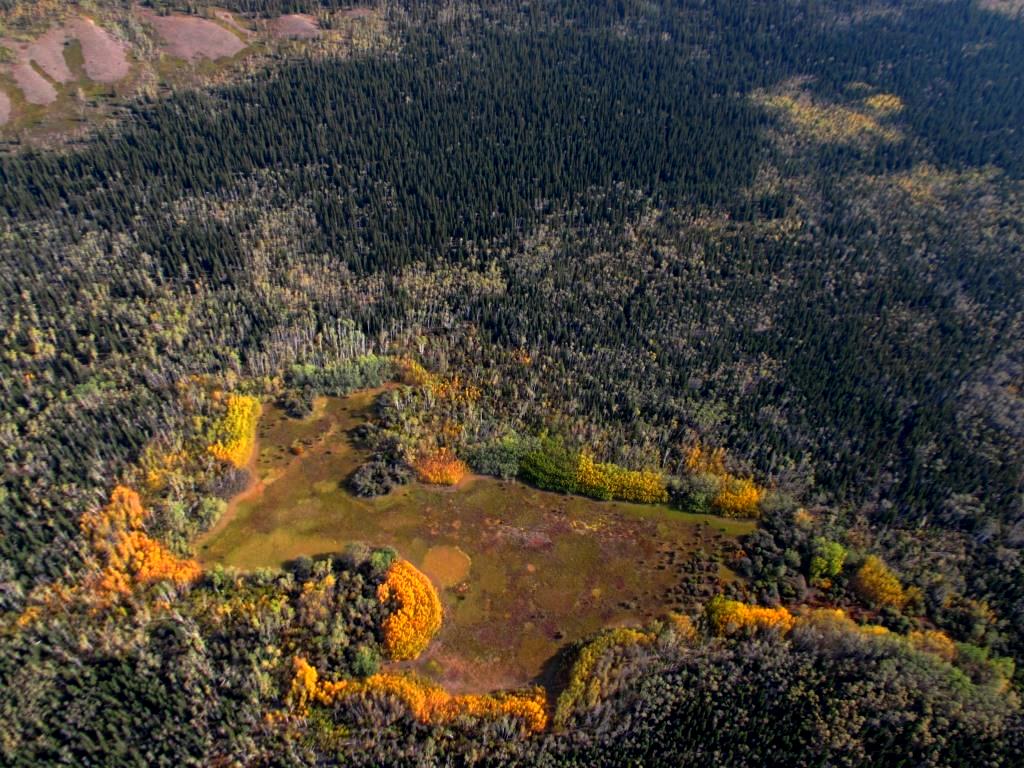
(Gord Allison photo)
By 1960 the Bradleys began harvesting what they were then calling the Nine-Mile meadow. Their first step was to construct a barge to get their haying equipment across the Pelly River. They lashed empty 45-gallon fuel barrels together, then set a wooden hay rack onto the barrels as a platform and containment for the tractor(s), mower, rake, hay wagon, and other necessities. The barge had to be moored close enough to shore to load the cargo on, but far enough out that it would still float when loaded. When the load was on and secured, the barge was tied to the front of their riverboat to be pushed across the river. It took three to four trips to get everything across, and after off-loading it was readied for the trip up the road to the meadow.
In the fall of 1962 Dick and Hugh’s brother Ken and his wife Dorothy and young sons Jordy and Dale moved to the ranch for a few years. Ken became involved in the meadow harvesting as well, and during the summers his one-ton truck was left across the river from the ranch for access to the highway as well as providing support for the haying work at the meadow.
For the first several years, the hay was cut with the tractor and mower and then raked into windrows. The hay was gathered up with a ‘sweep’, a wide framework of parallel dry wooden poles with pointed ends that was attached to the front of the tractor. It was pushed along the ground surface under the cut hay, which rolled onto the sweep until it was full. The sweep loads were then piled up together to make a haystack.

(Google)
The stacks were left in the meadow and retrieved in the winter when the river ice was safe for the tractor to travel on. It pulled one or two hay wagons mounted on sleigh bunks (runners) across the river and up the nine miles of road to the meadow. Bill Lammers, at the time living on the lower Pelly River near the ranch, recalls helping Dick Bradley at the meadow to load the hay from the stacks onto the wagons with pitchforks. Sometimes moose were found to have gotten into the stacks and made a mess of them.
In later years the Bradleys used a forage harvester that would cut the hay and blow it through a spout into a hay wagon being pulled behind or into the box of a three-ton truck driving along beside. These loads of hay were hauled back to the river and dumped into a silage pit there, from where it was later retrieved when the river was frozen.

(Gord Allison photo)
In 1965 the Bradleys, primarily Ken, began construction of a new road on the north side of the Pelly River from their ranch to Pelly Crossing. It was generally available for travel by 1967 and became the Pelly Ranch Road of present day, although it was not the nearly-all-weather gravelled road it is now and there were chances of getting stuck in the odd bog hole or when the road was wet.
One year around 1970 when preparations were being made to cut the hay meadow, it was decided that the little grey 1947 Ford 9N tractor should be driven there using this new road rather than barging it across the river. From the ranch it would be driven out to Pelly Crossing, down the highway to the Old Pelly Farm Road near Minto, and in on that road to the meadow. Hugh Bradley and I made this 68-mile trip on a nice August day on the little tractor that had a top speed of 11 miles per hour.

(Gord Allison photo)
A passenger riding on this small tractor had to either stand on the drawbar at the back or try to sit ‘side-saddle’ on a small space behind the seat. This length of trip required the rider to alternate between the two positions when either their legs or rear end got sore. In both cases hanging on to the top of a fender was a necessity for security. We would have had a lunch box with us, but there was little room to pack along much else.
Hugh and I took turns driving, but he drove the entire 19-mile stretch of highway from Pelly Crossing to near Minto because he had a driver’s licence (the tractor being unlicensed was apparently of no concern). To occupy ourselves on the slow drive along the highway we counted the beer and pop bottles that were often thrown out of vehicle windows into the ditches in those days. I do not now recall the count, but it was well into the hundreds I believe.
The tractor trip to the hay meadow on a warm and sunny day was a long but enjoyable venture. We travelled by other means the nine miles on the old farm road to the Pelly River and across by boat to the ranch for the night. The next day was a return to the meadow to get the work of cutting the hay underway.
Harvesting the Nine-Mile meadow probably took a week or more to get the machinery and equipment from the ranch to the meadow, cut and pile (or haul) the hay, and demobilize everything back. It involved daily travel to the meadow and back because there were morning and evening chores to tend to at the ranch.
There are no records of the amount of hay cut from the Nine-Mile meadow over the years, but it is estimated that they harvested the loose-hay equivalent of around 100 of the round bales that are commonly used today. The last year the meadow was cut by the Bradleys appears to have been 1972, when they had enough new land in production at their ranch to feed their cattle.
The meadow haying times were long days of hard work, but with the feel of an adventure. Time spent with Dick and Hugh Bradley along with Ken and Dorothy Bradley and their children Jordy, Dale, and Gwen was always fulfilling. More than 50 years after the meadow was last cut, the Pelly River Ranch is still in the family, owned and operated by Dale Bradley and his wife Sue.
A Last Look – The Nine-Mile Meadow Revisited
After the final year of harvesting hay from the Nine-Mile meadow in 1972 and with the Pelly Ranch Road of today by then in place, there was no longer any need for the Bradleys to travel on the Old Pelly Farm Road. Hugh saw the meadow one more time in 1995 on a search for some wandering cattle, but Ken didn’t get there again. Ken passed away in June 1996 and Hugh in August 2012.
Their older brother Dick had been the one most involved in the work at the Nine-Mile meadow, both in cutting the hay and then later hauling it home in the winter, sometimes in very frigid conditions. In August 2013 a trip was planned with Dale Bradley to take his 84-year old Uncle Dick out on the Old Pelly Farm Road to the meadow. Dale’s teenaged son Ken and a farm helper from Germany named Max also came along after first spending many hours cutting a trail around a section of the old road near the ranch that had been eroded away.
We wanted Dick to have a comfortable ride in the bush, so decided to take him in my side-by-side all-terrain vehicle. In a scene somewhat reminiscent of Dick and his brothers barging their haying equipment across the river decades previously, we loaded the side-by-side across the gunwales of Dale’s boat and ferried it across the river.
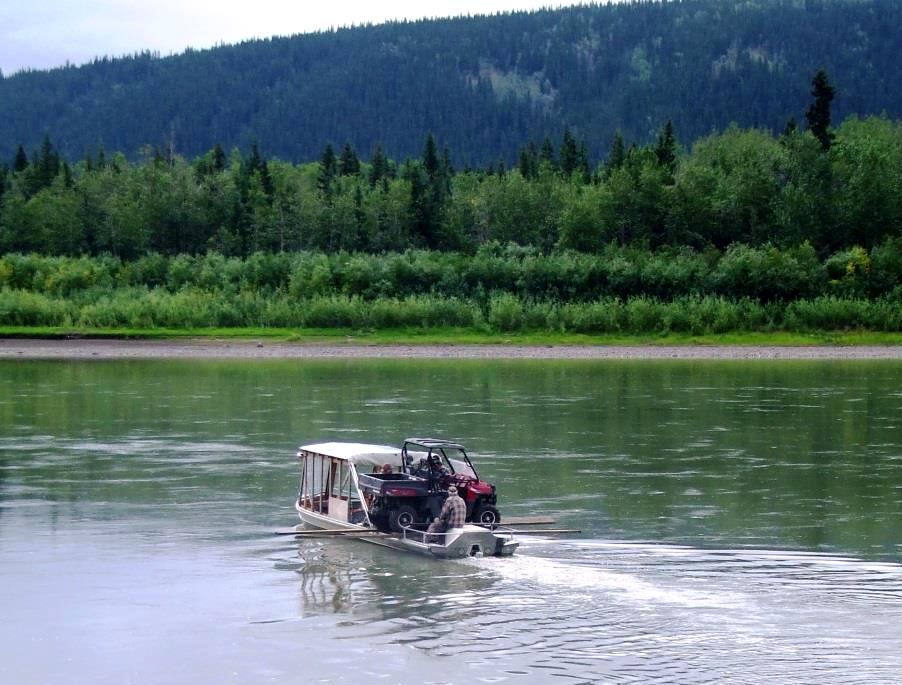
(Dorothy Bradley photo)
The nine-mile stretch of road from the river to the meadow that Dick helped build 55 years earlier in 1958, and had last been on about 40 years previously, had grown in greatly since any of us had been on it. It took a significant amount of cutting to get the side-by-side through, particularly in an area where a forest fire had burned through in the intervening years.
When we eventually got to the meadow, Dick looked around and said he hadn’t been sure what to expect. He said that it had grown in quite a bit since he last saw it, but he had thought maybe it would have completely disappeared. He seemed to enjoy having another look at this productive spot in the bush where he had devoted a fair amount of his time, energy, and resourcefulness.
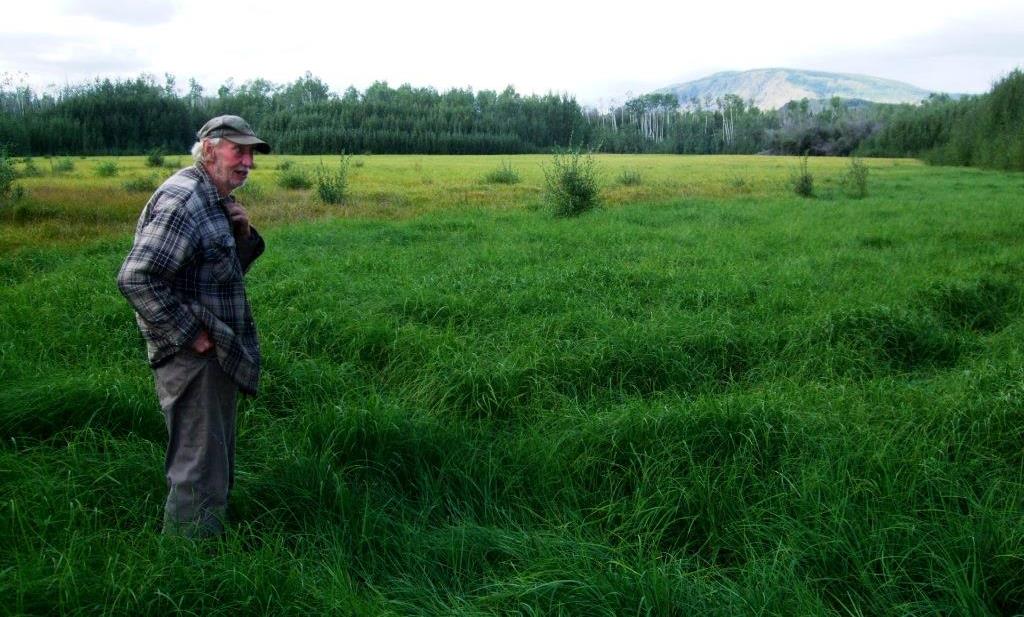
(Gord Allison photo)
Dick Bradley passed away in July 2021 and joined his brothers Hugh and Ken at their resting places on a knoll overlooking the Pelly River Ranch. Among the many other innovative things they did during their lives on the ranch, the Bradley brothers may have been the last to carry out an activity of a bygone era – the harvesting of wild hay from a Yukon meadow.
Link to Part 2 (The Minto-Fort Selkirk-Pelly Crossing Meadows)
Link to Overland Trail article
Revised 9 May 2024
Revised 8 June 2024
Thank you so much, Gord, for this great article written with personal knowledge of the time and the actors involved. Dick, Hugh and Ken Bradley were true Yukon pioneers of a bygone era and wonderful
human beings. They had an understated old time capability and modesty that seems to no longer exist nowadays with the sense of humour to go with it. Let’s hope the Bradleys can keep their ranch going for a long time!
Heinz Sauer
Thank you for the great comments, Heinz. You have some of that same personal knowledge and your description of the Bradleys is bang on. Dale is from that same mould as his Dad and uncles and made the revisit to the meadow with his Uncle Dick possible, as the photo of his boat and the side-by-side shows.
The Bradley story is wonderful piece of Yukon history and we are very fortunate Gord to have you live some of it and know it so well. This is pioneer living at its best with very resourceful people.
Thank you for commenting, Boyd. I’m the fortunate one for getting to spend all that time there, but I’m glad to be able to pass along some of this history to people like you who appreciate it. This kind of stuff could become lost history otherwise, as the Bradleys aren’t ones to talk themselves up about the things they’ve done.
Great stuff as usual Gord, I had no Idea this activity took place, does explain a few trails I have seen in my travels and wondered where they went. I knew from talks with my Dad that WP&YR had hay operations along the Dawson Trail but never occured to me that others were doing it and harvesting’Wild’ hay. The Bradely’s and crew were/are a tribute to the Homesteading! Keep up the great work!
Thank you, Frank. I have seen at least one place where White Pass harvested wild hay along the Overland Trail, but there were undoubtedly more. The one I know of was between the Pelly and Stewart Rivers at Grand Valley Creek – the expanse of meadows there apparently gave it that name. The Pelly Farm supplied hay and probably grain they grew to roadhouses along the Trail as well. My next article will be about other meadows cut for hay, almost all of which are places hidden in the bush that few people now see. I appreciate your comments.
Somewhere here in my house I Keep a number of old National Geographic magazine about things that I took and take a Great interest in. The Klondike and laterAlaska goldrushes.
In one of them is an article about the Pelly River ranch. I must find it and read read it.
Eventually I manager to go to Dawson City by bus from Whitehorse. (starting my bus trivs in Toronto)
I never manager to get to the ranch though, but I found this article most interesting. Canoe friends have paddlade the Pelly, so I guess they were in the area.
Thank you for posting this fine article.
Bertil Wockatz from Sweden
Hi Bertil. I don’t know if there was more than one National Geographic with the Pelly River Ranch in it, but the April 1978 edition has a section on the ranch as part of a larger Yukon article. If you had friends that paddled the Pelly River and went to Fort Selkirk, then they would have gone by the ranch. In 2004 Hugh Bradley of the ranch went to your country for a Circumpolar Agricultural Association conference at Umea. What I remember him talking about the most when he got back was seeing moose being milked there. Thanks for your comments.
Thanks Gord, another great read. I’ll look forward to the next installment. Some familiar names in this story. I wonder if the John Stelfox mentioned is the same fellow who went on to a career as a biologist with Alberta Fish and Wildlife and the Canadian Wildlife Service. No doubt that the trail from Minto to Pelly River would have been challenging at times.
Yes, it’s the same John Stelfox. He worked at the Haines Junction experimental farm during the summers of 1950 to 1953 while going to university. He first went to the Pelly Farm in 1950 as part of some studies that were being done there for northern agriculture. I visited him in Vernon, BC a few times in his later years. I always appreciate your comments, Rob, thank you.
Thank you Gord for describing so well the haying operation that Dick and his brothers had going at 9 mile meadow. They were farmers bred in the bone and exceedingly generous and friendly. We always knew the meadows as “Atkinson Meadows” when traveling by land into our home on the lower Pelly River. Incidentally, there is a gov’t file with a letter (June 2, 1913) from W.H. Atkinson claiming C.E. Carpenter is applying for a parcel of meadow land of which on 20 acres Atkinson has made improvements. I probably originally got the Atkinson meadow name from Bill Harris at Minto. The “Dawson Road” was Bill’s access to his trapline cabin. Carol and I used the old road extensively until 1987 when we exclusively switched to the pioneer road (much upgraded) that Ken had made many years before on the ranch side of the Pelly River out to the Klondike Hwy. Carol’s guest book has 4 men from Sweden stopping at our place August 7, 1981. They had earlier been to the ranch.
Thanks for the comment and all the information, Lew. I will soon be putting out the next article on other meadows in that area, and the Atkinson name will come up again. There seems to be a little confusion about meadow names, but I’m hoping the article will clear this up, as supported by archival research as well as some local knowledge.